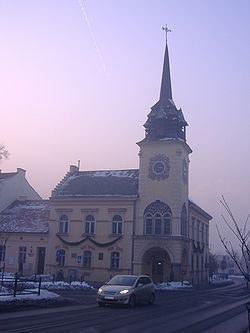Gmina Skawina Postal code 32-050 Area 20.5 km² Population 27,691 (2008) | Time zone CET (UTC+1) Car plates KRA Local time Thursday 12:39 PM | |
 | ||
Weather 8°C, Wind NE at 19 km/h, 89% Humidity Points of interest Muzeum Regionalne w Skawinie, Synagoga Chewra Thilim, Ratusz elektryczny | ||
Skawina [skaˈvʲina] is a town in southern Poland with 27,328 inhabitants (2008). Situated in the Lesser Poland Voivodeship (since 1999), previously in Kraków Voivodeship (1975–1998). The town is located on the Skawinka river, in close proximity to the city of Kraków. Its population (as for December 31, 2010) was 23,761, and the area of the town is 20,50 km2. One of the most interesting historic buildings in Skawina is a Renaissance palace, built in the mid-16th century by Paweł Korytko. The name of the town probably comes from the Skawinka river.
Contents
Map of Skawina, Poland
History
In the late 13th century, three villages existed here: Babice Nowe, Babice Stare and Pisary. They belonged to the Tyniec Benedictine Abbey. In the Middle Ages, the Skawinka marked for a while the boundary between Silesia and Lesser Poland, which resulted in construction of a defensive gord, which protected the city of Kraków from the south. On May 22, 1364, King Kazimierz Wielki granted Magdeburg rights to Skawina, and a few years later, the parish church of Holy Spirit was funded here. Skawina was the seat of a wójt, and remained in the hands of the Benedictine monks. The town had a defensive wall and a castle, which was the residence of the wójt. In 1509, Skawina burned in a fire, but the town was quickly rebuilt and enjoyed the prosperity of the Polish Golden Age. Good times ended in the Swedish invasion of Poland, when Swedish and Transilvanian armies destroyed Skawina, reducing its population by 50%. After the Partitions of Poland, Skawina became part of Austrian province of Galicia (1772). The town remained poor and backward until the second half of the 19th century, when Skawina became a railroad hub, with three lines, to Kraków, Sucha Beskidzka, and Oświęcim. A brewery was built and new businesses were opened.
In the Second Polish Republic Skawina belonged to the Kraków Voivodeship. On September 6, 1939 the first Wehrmacht troops entered the town, and the German occupation lasted until January 23, 1945. The Communist government of People's Republic of Poland decided that Skawina would become a center of heavy industry. In 1954, the Skawina Aluminum Works (Huta Aluminium Skawina) were opened, and in 1961 the Skawina Power Station (Elektrownia Skawina) went on line. The aluminium works were closed in 1981 due to the widespread pollution they caused. The growth of industry resulted in an influx of new residents and the construction of several apartment blocks in new districts of the town.
Twin Towns - Sister Cities
Skawina is twinned with:
Sports
Skawina is home to sports club Skawinka, founded in 1922.
